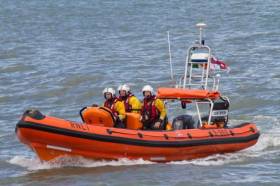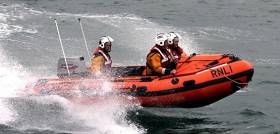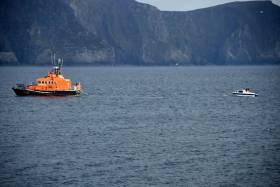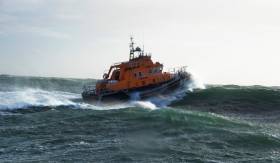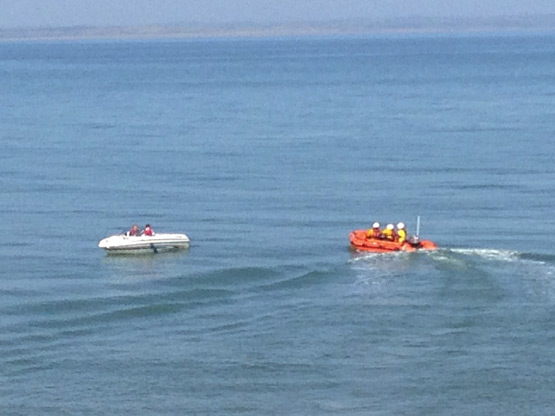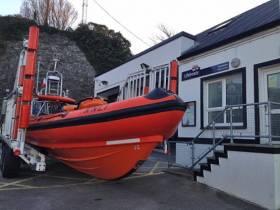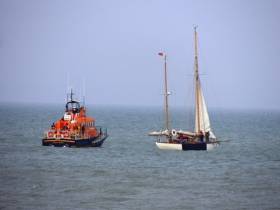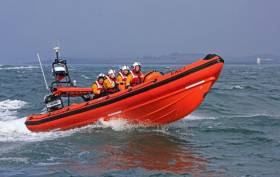Displaying items by tag: Lifeboats
#RNLI - Kilmore Quay RNLI's volunteer lifeboat crew were alerted at 1.43am yesterday morning (Thursday 19 May) to reports of an injured fisherman 40 miles offshore.
The injured crewman was on board a 20m stern trawler fishing for prawns at the Smalls fishing grounds south-southeast of Kilmore Quay. He had fallen and was in chronic pain suffering with a suspected dislocated shoulder.
The all-weather lifeboat departed a short time later with weather conditions described as good with a slight swell from the Southwest and clear visibility, enabling the lifeboat make 25 knots towards the casualty.
With the fishing vessel making seven knots towards the lifeboat, they rendezvoused at 3:30am. The fair conditions made for a quick transfer of the injured crewman to the lifeboat and once on board the lifeboat he was made comfortable.
The journey back to Kilmore Quay took just under 90 minutes and on return the injured man was handed over to paramedics for transfer to Wexford General Hospital and treatment to his injuries.
#RNLI - Kilkeel RNLI helped bring a fisherman to safety yesterday evening (Tuesday 17 May) after he was injured while fishing for prawns off the Co Down coast.
The volunteer lifeboat crew was alerted at 4.50pm and requested by Belfast Coastguard to go to the aid of an injured man on a 68ft fishing trawler in Dundalk Bay.
The inshore lifeboat, helmed by Alan Henning and with three crew members onboard, launched within minutes and made its way to the scene some six nautical miles from the lifeboat station.
Weather conditions at the time were described as wet with a lot of rain and a 1.5m swell.
Once on scene, lifeboat crew member Andrew McConnell was transferred from the lifeboat on to the fishing vessel, where he assessed the casualty and ensured he was wearing a sea survival suit before being moved from the trawler.
The injured man was made comfortable before he was strapped and lowered down into the lifeboat where he was then transported back to Kilkeel and handed over into the care of a waiting ambulance.
Speaking following the callout, Kilkeel RNLI lifeboat operations manager John Fisher said: "There wasn’t enough water in the harbour yesterday afternoon to allow the fishing trawler make its way into Kilkeel so we were happy to assist.
"We would like to wish the injured man a full and speedy recovery from his ordeal."
Skerries Lifeboat Assists Teen On Personal Water Craft
#RNLI - Skerries RNLI responded Sunday evening (15 May) to reports of a personal water craft in distress off the Martello tower in Loughshinny.
Dublin Coast Guard tasked Skerries RNLI just after 6pm having receiving a 999 call about a person on a personal water craft who appeared to be signalling for help.
The location was given as being in line with the Martello tower situated on a headland near Loughshinny Harbour.
The lifeboat was launched with volunteer Eoin Grimes at the helm and crewed by Emma Wilson, Steven Johnson and AJ Hughes.
Arriving on scene, the crew quickly located the casualty, a 17-year-old whose personal watercraft had encountered mechanical difficulties and was drifting.
The teenager was taken on board the lifeboat and his vessel was taken under tow. He was returned to Portmarnock beach where he had friends waiting to offer assistance. The lifeboat then returned to station.
Speaking after the callout, Skerries RNLI lifeboat operations manager Niall McGrotty said: "With the good weather meaning more people are taking to the sea, we would like to remind people that it is advisable to have their vessels fully serviced after the winter and to always carry a means of contacting the shore."
Fethard RNLI has assisted two people onboard a pleasure craft which got into difficulty off the Wexford coast this afternoon (Sunday 15 May).
The volunteer crew launched their inshore lifeboat at 3.40pm following a request from Waterford River Rescue which reported that a 21ft Bayliner pleasure craft with two people onboard had got into difficulty.
The vessel had sustained engine failure at Creadan Head, some three miles upriver from Dunmore East.
The D Class lifeboat helmed by Thomas Stafford launched at Duncannon and made its way to the scene.
Weather conditions at the time were described as good with a fresh south westerly on shore breeze.
A local fishing vessel aided the operation by providing the lifeboat crew with the exact location of where the pleasure craft was.
Once on scene, the lifeboat crew observed that no one was in any immediate danger and began to establish a tow line.
Fethard RNLI proceeded to bring the vessel one mile up stream where the crew then handed the tow over to Waterford River Rescue who brought the vessel safely back to Waterford.
Speaking following the call out, Thomas Walter, Fethard RNLI Helm said: ‘Today’s call out was an example of good team working between ourselves and our colleagues in Waterford River Rescue. We were delighted to assist and wish the two sailors well.’
Three Callouts In 24 Hours For Achill Lifeboat
#RNLI - If ever the importance of a constant state of readiness was underlined then a single 24-hour period, this week has been a reminder of this for the volunteer lifeboat crew at Achill RNLI.
The first of three callouts came on Wednesday night (11 May) at around 10.30pm when the station’s all-weather lifeboat Sam and Ada Moody was requested to launch by the Irish Coast Guard to support the evacuation of an elderly patient from Inishturk Island, who was transferred to hospital by coastguard helicopter.
On Thursday afternoon (12 May) at 5.15pm, the lifeboat was called on again, this time to locate and rescue a small cabin boat that encountered engine failure about a mile and a half west of Dooega Head.
The distressed boat, which was crewed by four people, had to be located and then towed to Purteen Harbour, where it was brought safely ashore by a D-class inshore boat from Achill Coast Guard. Excellent weather conditions were a help to the smoothness of the recovery.
Finally, on Thursday evening a local doctor requested the assistance of Achill RNLI to take a patient from Clare Island into Cloughmore, where the patient was transferred by ambulance to hospital.
Speaking following their busy 24 hours, Achill RNLI coxswain Dave Curtis said: :Our volunteers are always on call and ready to respond when needed and we were delighted to be of assistance.
"The response to each call out demonstrated good team work with our colleagues in the coastguard, while the rescue of the cabin boat was a good example of our RNLI training paying off. We would like to wish the patients a speedy recovery."
#RNLI - Rosslare Harbour RNLI volunteers launched their all-weather lifeboat at 7.30am yesterday morning (Sunday 8 May) to answer a call from the Irish Coast Guard to assist a local fishing boat with engine problems.
A very dense fog was down but the skill of the lifeboat navigators and crew ensured a quick location of the vessel, which was a short distance from Rosslare Burrow point off the Wexford coast.
"With a visibility of less than 200 metres, the lifeboat crew did extremely well to locate the vessel so quickly," said Rosslare Harbour RNLI volunteer lifeboat press officer Jamie Ryan.
"This type of weather can come in fast and can be extremely challenging when a vessel suffers engine problems. Thankfully it was a successful callout."
Hours later, Newcastle RNLI launched to assist an adult and child safely back to shore just off Newcastle Harbour in Co Down.
Three volunteer lifeboat crew launched the inshore lifeboat to assist a leisure craft which experienced engine failure. Once on scene, the crew established a tow and proceeded to Newcastle Harbour.
Newcastle RNLI Helm Niall McMurray said: "We’re always happy to help where we can and thankfully conditions were calm with no one injured."
Dunmore East RNLI Raises Vital Mayday Funds
#RNLI - Vital funds have been raised for the RNLI following the annual Dunmore East lifeboat 'Dash & Splash' and yellow welly throwing competition.
The event, which took place at Councillor’s Strand in Dunmore East on Sunday 1 May, was run as part of Mayday, the RNLI’s national annual fundraising campaign.
Dunmore East RNLI fundraising branch volunteer Carol McGeary said: "I’d like to thank everyone who came and supported the Dash & Splash and yellow welly throwing competition.
"We were especially delighted to have Senator Grace O’ Sullivan taking part and leading the swimmers into the water.
"We all had great fun with the welly throwing competition and the crew even challenged our supporters to a beach soccer match. The funds raised will help the RNLI continue to save lives at sea’.
McGeary added that RNLI volunteers in Dunmore East and around Ireland "are willing to drop everything to go and save lives at sea when their pagers beep.
"Mayday is the RNLI’s own call for help, as we rely on the generosity of the public to continue our lifesaving service, which we operate day and night, 365 days a year."
Many of the Mayday fundraising events that have taken place across the country have had a yellow welly theme, in a nod to the essential kit that the RNLI’s lifeboat crew members wear on their feet when they go out to sea to save lives.
Money raised through the Mayday campaign – which ran from Tuesday 26 April to Monday 2 May – will support the RNLI’s lifesaving work. It could be used to fund crew training, contribute towards the running costs of a lifeboat station or buy new crew kit like the yellow wellies.
There is still time to support Mayday. Visit RNLI.org/Mayday to donate.
The RNLI operates 45 lifeboat stations around Ireland. Last year, RNLI lifeboat crews in Ireland launched 1,098 times bringing 1,244 people to safety.
Bundoran RNLI Soapbox Race Returns For Fifth Year
#RNLI - The eagerly anticipated Bundoran RNLI Soapbox Race makes its return to Bundoran’s Astoria Road on Bank Holiday Sunday 5 June.
Following last year’s cancellation of the event due to unfavourable weather conditions, the volunteer lifeboat crew are this year determined to make the fundraising event even better than ever.
The current holders of the title of soapbox champions are Bundoran’s Ward Automation and they are anxious to retain their title.
Spectators can expect the usual excitement that they have grown to expect since the event began back in 2012 with participants encouraged to begin the build of their soapbox so that it is ready on time.
The €1,000 ball race will also make a welcome return on the day with balls being sold for €5.
Each ball is numbered and then released down the hill. The first ball through the funnel at the end will win the €1,000 which has been donated by local businesses. Balls will be on sale on the day.
The event will kick off at midday with a skate competition as local longboarders display their skills in advance of the soapbox race. The soapbox race will follow with the day coming to a close with the ball race.
Bundoran RNLI event co-ordinator Cormac McGurren is encouraging all budding soapboxers to start building.
"The countdown is on and we want to see as many soapboxes taking part as is possible," he says. "We would love to see all the local businesses involved and competing against each other to have plenty of friendly rivalry on the day.
"We would also encourage locals and visitors alike to come along and enjoy a good day out. All proceeds raised will go to helping our volunteers in Bundoran to continue to save lives at sea."
All the details of the day, including registration forms, can be found online at www.bundoranlifeboatsoapboxrace.com
Arklow & Bangor Lifeboats Have Busy May Day Weekend
#RNLI - Lifeboats from Arklow and Bangor were out on the water for separate callouts on May Day yesterday in what made for a busy weekend for the RNLI crews.
In Arklow, RNLI lifeboat volunteers were alerted by pager around 7pm on a fine Sunday evening (1 May) to a call for help from a vintage sailing vessel.
The lifeboat Ger Tigchleaar was launched within minutes to the classic boat, which has suffered engine failure and was stranded just east of Arklow Harbour.
The Arklow RNLI volunteer crew established a tow line and proceeded to tow the vessel safely back into Arklow. The five experienced crew members on the casualty vessel remained aboard during the tow home and all hands came ashore safely at Arklow.
Speaking after the incident, volunteer lifeboat press officer and community safety officer Mark Corcoran said: "On this, the RNLI’s Mayday fundraising weekend, our fundraising team and boats crew have been busy with all kinds of fundraising events.
"Even after a long day of fundraising our dedicated volunteers turned up this evening en masse to go to the aid of the crew of this stricken vessel.
"We’re all very proud to be involved with the RNLI, so please give generously to the Mayday campaign to help keep us doing what we do, which is saving lives at sea."
Elsewhere on the same evening, Bangor RNLI’s volunteer lifeboat crew launched to the aid of a RIB with engine failure just off Royal North Yacht Club in Belfast Lough.
Although not in immediate danger, a strong breeze was blowing the vessel, with one person on board, offshore. Thankfully the Bangor inshore lifeboat was able to tow the RIB in to Royal North without incident.
Bangor RNLI volunteer helmsman Gareth Whan said: “The crew and I are delighted to have been able to return this vessel safely to shore. Engine failure can happen in the best-maintained boat, and we are pleased to have been able to help.”
This was Bangor RNLI’s second callout of the weekend. On Friday evening (29 April) they were asked by Belfast Coastguard to assist Lagan Search and Rescue and other emergency services in a detailed search of Belfast Harbour for a person in the water.
Sadly, this callout did not have a happy ending. The search was called off after three hours, and resumed on Saturday morning. However, it was only yesterday (Sunday 1 May) when a body was found by police divers.
Bangor RNLI extended its sympathies to the family of the man and all involved in the attempted rescue.
“It is sadly appropriate that both of these launches happened during the May Day weekend, a key fundraising time for the RNLI, and highlight the importance of the work our volunteers do,” said Bangor's deputy launching authority Bryan Lawther.
#RNLI - The volunteer lifeboat crew at Portaferry RNLI responded to a launch request from the coastguard yesterday morning (Saturday 30 April 2016) to assist two men on board a yacht stranded on rocks in Strangford Lough, Co Down.
Portaferry's inshore Atlantic 85 launched at 9.22am and the volunteer crew were quickly on scene at Long Rock, just off East Down Yacht Club, 10 minutes later.
Weather conditions at the time was cloudy with good visibility, a Force 3 north westerly wind and calm sea.
When the RNLI crew arrived, they fixed a line to the 28ft yacht and towed it off the rocks.
Once their yacht was free, the two men on board proceeded to East Down Yacht Club accompanied by the Portaferry lifeboat crew, who remained with the yacht until it was safely returned to the pontoons at the yacht club.
After the callout, Portaferry RNLI lifeboat operations manager Brian Bailie said: "It has been a busy few months for the crew in Portaferry and we were delighted to have been able to assist these two men who had run into some difficulty.
"We are now entering our most busy time of year and we would urge everyone taking to the water to make sure that they prepare properly and check that all equipment is tested and in good working order."
The RNLI offers sea safety advice online at RNLI.org/RespectTheWater






























